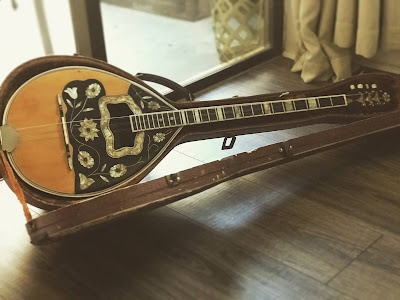The mystery 1960s three course bouzouki-Part II
Circling closer to the bouzouki maker!
I had previously asked reputable famous soloists / musicians, hard-core collectors, and master luthiers for their input regarding the potential maker of this musical instrument.
Their feedback focused around two (2) master luthiers :
1. Zozef Terzivasian, (due to the decoration of the pickguard, the sound-hole and the pyramid-shape braces under its soundboard)
2. Kyriakos Lazaridis/Pesmatzoglou, ( due to the flower decoration of the headstock , the overall style , and the treble-mid timbre of its sound)
Two (2) more luthier names were also proposed , but both of these (names) were returning a closer collaboration back to the two master luthiers mentioned above.
Konstantinos Agelidis (due to a similar bouzouki possessed by a famous soloist made initially by Kyriakos Lazaridis but re-braced by Agelidis) and Anastasios Lekkas. ( due to the fact he was supplying Zozef Terzivasian with bouzoukia instrument similar to this one ) .
As the bouzouki is currently for sale, and as, many buyers asked for more information regarding the potential maker of the musical instrument , I returned back to my files and dived deeper into a time-consuming research.
At first, and after an intense research on hundred of old black and white Greek films ( from 1960s-1970s) this particular sound-hole and pickguard decoration appears nowhere else!
1. Up to now, we only know one bouzouki with similar sound hole and pickguard decoration played by the famous soloist Iordanis Tsomidis during his tour in Amsterdam Holland.
Unfortunately, the old photograph of Antonis Roussos playing his bouzouki (Zozef Terzivasian) , (found on social media ) doesn't reveal the complete instrument. For this reason we can't with 100% confidence say that this is an identical bouzouki.
But from a closer look Mr. Roussos' bouzouki has many more similarities, comparing to the one played by Mr Tsomidis
1. The headstock flower decoration is the same as the one on my 1960s bouzouki. Three thick triangulated leaves, with a long stem and a triangle shape at the base.
2. The sound hole shape, and the flowers decoration close to the neck are also the same.
3. The fret markers are finally the same . Celluloid rectangular fret markers are installed from fret # 1 up to the connection of the neck to the bowl. Round dots as fret markers are installed after the bowl connection, towards the sound-hole
As I mentioned above, the limited visibility of the complete pick-guard design, also limits us to state with 100Α% confidence that Antonis Roussos' bouzouki is identical to the mystery 1960s bouzouki. But now, we are more confident than before, to support the hypothesis that the 1960s bouzouki was a custom made musical instrument, created by a famous luthier.
Taking also in consideration that the head-stock design and decoration of a bouzouki , and the bridge shape are usually the trademarks of each luthier's creation, then we may be closer than expected to identify the master luthier of the 1960s mystery flowered-design bouzouki.
Updates
3. A third Zozef Terzivasian bouzouki of the early 1960s , with great similarities to mine, came up recently to the surface. Belongs to a bouzouki/Rebetiko researcher, renowned author, hardcore collector and bouzouki player. The photograph was provided long time ago in one of our conversations regarding Zozef Terzivasian , but I totally had forgotten about it. Also the same photograph was recently re-sent to me by another Rebetiko enthusiast and social media friend.
In my opinion, the latest finds almost "seal the deal" that the mystery 1960s bouzouki was indented for, or belonged to Zozef Terzivasian's workshop. Three (3) out of three (3) early 1960s bouzouki with substantial similarities sold by Zozef Terzivasian workshop.
To be continued!









Comments
Post a Comment